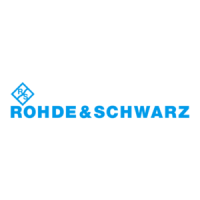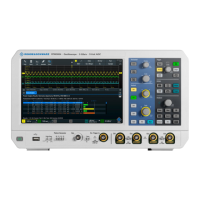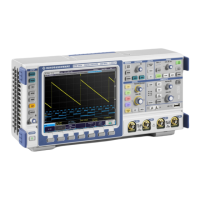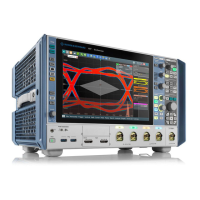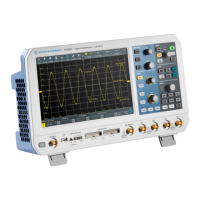Serial bus analysis
R&S
®
RTM3000
292User Manual 1335.9090.02 ─ 09
Bin / Hex pattern ← Identifier condition
Defines the identifier or data pattern in binary and hexadecimal format. To set an indi-
vidual binary bit or hex nibble (half byte), tap it and enter it via the on-screen keypad.
"Bin"
String containing the binary pattern with a maximum of 64 bits. Char-
acters 0, 1 and X are allowed.
"Hex"
String containing the hexadecimal pattern with a maximum of 8 bytes.
Characters 0 to F and X are allowed.
Remote command:
TRIGger:A:CAN:IDENtifier on page 642
TRIGger:A:CAN:DATA on page 643
Symbolic ID ← Identifier condition
If a label list with symbolic names was loaded and applied in the bus configuration, you
can select a symbolic name from the list instead of entering the numeric identifier. The
instrument triggers on the identifier of the selected node.
Data condition
The data condition consists of the following settings:
●
Length of the data pattern
●
Comparison
●
Data pattern, see "Bin / Hex pattern" on page 292
Data ← Data condition
Defines the length of the data pattern - the number of bytes in the pattern.
Remote command:
TRIGger:A:CAN:DLC on page 642
Compare ← Data condition
Sets the data comparison condition. If the pattern contains at least one X (do not care),
you can trigger on values equal or not equal to the specified value. If the pattern con-
tains only 0 and 1, you can also trigger on a range greater than or lower than the speci-
fied value.
Remote command:
TRIGger:A:CAN:DCONdition on page 642
13.5.4 CAN decode results
When the configuration of the serial bus is complete, the signal can be decoded:
1. In the "Bus" menu, enable "Decode".
2. In the "Display" menu, select the result display settings.
See Chapter 13.1.2, "Displaying decode results", on page 253.
3. In the "Bus Table" menu, enable the "Bus Table". Adjust the table settings.
See also: Chapter 13.1.3, "Bus table: decode results", on page 254
CAN (option R&S
RTM-K3)

